Categories
Archives
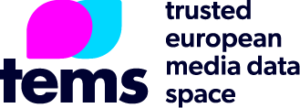
The IPTC is happy to announce that it will be working as an affiliate organisation of the TEMS project to build a Trusted European Media Data Space.
The product of a two-year-long tender and award process with the European Commission, TEMS is a joint undertaking of 43 organisations representing hundreds of stakeholders from 14 countries in the cultural and creative sectors, which aims to conceive and implement a common media data space across Europe.
The initiative is supported by the European Commission’s Digital Europe Programme (DIGITAL) and is a core element in the implementation of the European Data Strategy. With an investment of EUR 16.5 million, the consortium represents a milestone in the way the media sector will be able to share and extract value from data. By doing so, TEMS aims to support the economic development and future growth of local and regional media ecosystems across Europe.
Concretely, TEMS will lead the way for the large-scale deployment of cutting-edge services, infrastructures, and platforms. It will also address fighting misinformation, audience analysis, improving data flows in production chains, and supporting the adoption of AI and Virtual Reality technologies.
TEMS will evolve existing media platforms, embryonic data space infrastructures and provide open access to a common data space for any interested media stakeholder from any media sub-sector. This will help digital transformation and improve the competitiveness of the European media industry.
IPTC’s role is an advisory one. We will be working with TEMS partners on structuring data models and metadata formats, re-using and extending existing IPTC standards to create the framework the will power the data sharing for the media industry and beyond.
The TEMS partner organisations range from global news organisations to data platform providers, broadcasters, archives and media innovation units, as can be seen below.

To follow news from the TEMS project, see http://www.tems-dataspace.eu/ or follow @TEMS_EU on X/Twitter.
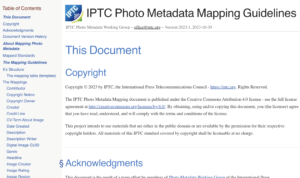 The IPTC is happy to announce the latest version of our guidance for mapping between photo metadata standards.
The IPTC is happy to announce the latest version of our guidance for mapping between photo metadata standards.
Following our publication of IPTC’s rules for mapping photo metadata between IPTC, Exif and schema.org standards in 2022, the IPTC Photo Metadata Working Group has been monitoring updates in the photo metadata world.
In particular, the IPTC gave support and advice to CIPA while it was working on Exif 3.0 and we have updated our mapping rules to work with the latest changes to Exif expressed in Exif 3.0.
As well as guidelines for individual properties between IPTC Photo Metadata Standard (in both the older IIM form and the newer XMP embedding format), Exif and schema.org, we have included some notes on particular considerations for mapping contributor, copyright notice, dates and IDs.
The IPTC encourages all developers who previously consulted the out-of-date Metadata Working Group guidelines (which haven’t been updated since 2008 and are no longer published) to use this guide instead.
 On Tuesday 12 November 2023, a group of news, journalism and media organisations released what they call the “Paris Charter on AI and Journalism.” Created by 17 organisations brought together by Reporters sans frontières and chaired by journalist and Nobel Peace Prize laureate Maria Ressa, the Charter aims to give journalism organisations some guidelines that they can use to navigate the intersection of Artificial Intelligence systems and journalism.
On Tuesday 12 November 2023, a group of news, journalism and media organisations released what they call the “Paris Charter on AI and Journalism.” Created by 17 organisations brought together by Reporters sans frontières and chaired by journalist and Nobel Peace Prize laureate Maria Ressa, the Charter aims to give journalism organisations some guidelines that they can use to navigate the intersection of Artificial Intelligence systems and journalism.
The IPTC particularly welcomes the Charter because it aligns well with several of our ongoing initiatives and recent projects. IPTC technologies and standards give news organisations a way to implement the Charter simply and easily in their existing newsroom workflows.
In particular, we have some comments to offer on some principles:
Principle 3: AI SYSTEMS USED IN JOURNALISM UNDERGO PRIOR, INDEPENDENT EVALUATION
“The AI systems used by the media and journalists should undergo an independent, comprehensive, and thorough evaluation involving journalism support groups. This evaluation must robustly demonstrate adherence to the core values of journalistic ethics. These systems must respect privacy, intellectual property and data protection laws.”
We particularly agree that AI systems must respect intellectual property laws. To support this, we have recently released the Data Mining property in the IPTC Photo Metadata Standard which allows content owners to express any permissions or restrictions that they apply regarding the use of their content in Generative AI training or other data mining purposes. The Data Mining property is also supported in IPTC Video Metadata Hub.
Principle 5: MEDIA OUTLETS MAINTAIN TRANSPARENCY IN THEIR USE OF AI SYSTEMS.
“Any use of AI that has a significant impact on the production or distribution of journalistic content should be clearly disclosed and communicated to everyone receiving information alongside the relevant content. Media outlets should maintain a public record of the AI systems they use and have used, detailing their purposes, scopes, and conditions of use.”
To enable clear declaration of generated content, we have created extra terms in the Digital Source Type vocabulary to express content that was created or edited by AI. These values can be used in both IPTC Photo Metadata and IPTC Video Metadata Hub.
Principle 6: MEDIA OUTLETS ENSURE CONTENT ORIGIN AND TRACEABILITY.
“Media outlets should, whenever possible, use state-of-the-art tools that guarantee the authenticity and provenance of published content, providing reliable details about its origin and any subsequent changes it may have undergone. Any content not meeting these authenticity standards should be regarded as potentially misleading and should undergo thorough verification.”
Through IPTC’s work with Project Origin, C2PA and the Content Authenticity Initiative, we are pushing forward in making provenance and authenticity technology available and accessible to journalists and newsrooms around the world.
In conclusion, the Charter says: “In affirming these principles, we uphold the right to information, champion independent journalism, and commit to trustworthy news and media outlets in the era of AI.”
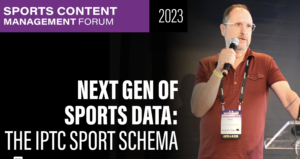
The IPTC Sports Content Working Group is happy to announce the release of IPTC Sport Schema version 1.0.
The first new IPTC standard to be released in more than 10 years, IPTC Sport Schema is a comprehensive model for the storage, transmission and querying of sports data. It has been tested on real-world use cases that are common in any newsroom or sports organisation.
IPTC Sport Schema has evolved from its predecessor SportsML. In contrast to the document-oriented nature of SportsML, IPTC Sport Schema takes a data-centric approach which is better suited to systems dealing with large volumes of data and also helps with integration across data sets.
“We reached out to many companies dealing with sports content and built up a clear picture of their needs,” says IPTC Sports Content Working Group lead Paul Kelly. “They wanted up-to-date formats, easy querying, the ability to handle e-sports and the ability to cross-reference between different media and data silos. IPTC Sport Schema addresses those requirements with a new basic model at the abstract end, and adhering to common use cases to keep things grounded.”
Content in Sports Schema is represented in the W3C’s universal Resource Description Framework (RDF), which renders any kind of data as a triple in the form of subject->predicate->object. Each component of a Sports Schema triple has a reference to an ontology, which defines the model at the heart of the standard. Querying is done using the W3C’s SPARQL standard, a kind of SQL for RDF.
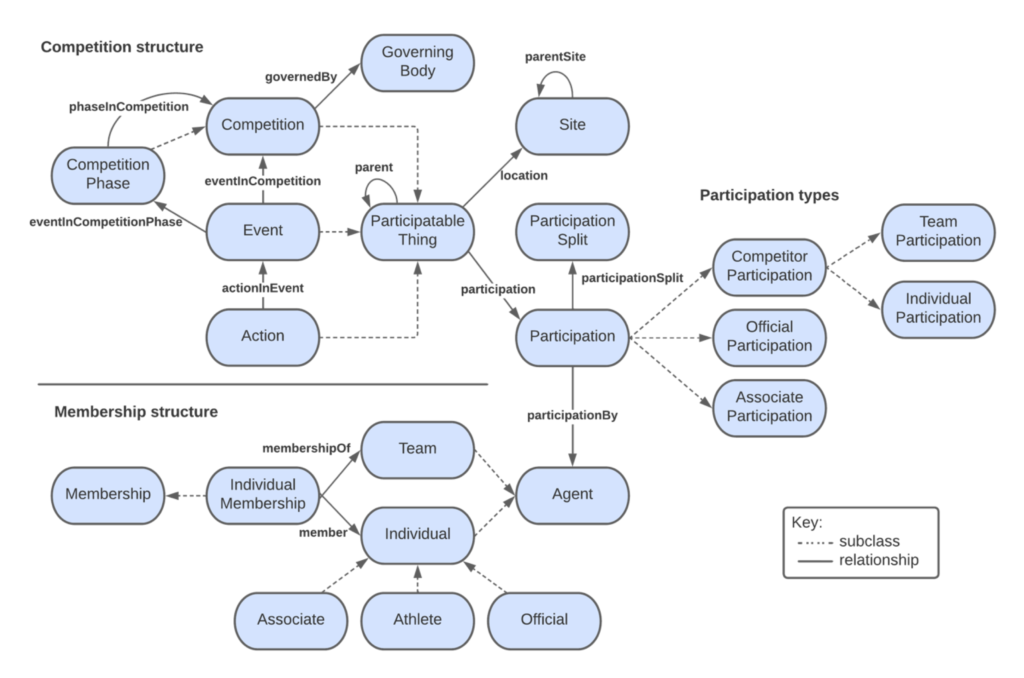
“The IPTC has been working on RDF and semantic web standards for more than 10 years, going back to rNews and RightsML,” said IPTC Managing Director Brendan Quinn. “So we are very happy to release another semantic standard that can help organisations to publish and share sports data in a vendor-neutral, interoperable way.”
Being RDF-based, IPTC Sport Schema can be rendered in XML, JSON and the simple Turtle format, and can be converted easily between all three formats using free tools such as Apache Jena.
“Those familiar with SportsML or SportsJS should recognise the basic components of Sport Schema,” says Kelly, “both in the ontology and in the sports vocabularies introduced with SportsML 3.0, which were designed specifically with semantic technologies in mind.”
To support take-up and share information about the new standard, the IPTC has created a dedicated website, sportschema.org. The site contains:
- a list of use cases which were used to help design the schema and data structures
- example instance diagrams for various sports to help understand how the model can be applied to team, individual and other types of sports
- a data dictionary comparing IPTC Sport Schema to other prominent sport schemas (SportsML, ODF, BBC Ontology, etc.)
- A detailed and comprehensive IPTC Sport Schema ontology reference showing all classes, relationships and properties.
- A tool to validate Sport Schema data using the SHACL format to ensure RDF triples adhere to the specification (equivalent to XML Schema or JSON Schema)
- A tool to covert SportsML documents to IPTC Sport Schema data
- A set of unit tests and sample data files that were used to develop and maintain Sport Schema, including a bespoke unit test framework that ensures our example SPARQL queries continue to satisfy our use cases as the model evolves.
Those wishing to try out some SPARQL queries against some sports data should visit Sport Schema’s query endpoint. It includes example queries showing how to build a team roster, league standings and more from our sample data sets.
For more information on IPTC Sport Schema, see the IPTC’s landing pages on the IPTC Sport Schema standard, the standalone site sportschema.org, or the project’s GitHub repository.
If you are interested in joining those who are working on implementing IPTC Sport Schema in your project or your organisation, we would love to hear from you. Please contact us via IPTC’s contact form.

Made with Bing Image Creator. Powered by DALL-E.
Following the IPTC’s recent announcement that Rights holders can exclude images from generative AI with IPTC Photo Metadata Standard 2023.1 , the IPTC Video Metadata Working Group is very happy to announce that the same capability now exists for video, through IPTC Video Metadata Hub version 1.5.
The “Data Mining” property has been added to this new version of IPTC Video Metadata Hub, which was approved by the IPTC Standards Committee on October 4th, 2023. Because it uses the same XMP identifier as the Photo Metadata Standard property, the existing support in the latest versions of ExifTool will also work for video files.
Therefore, adding metadata to a video file that says it should be excluded from Generative AI indexing is as simple as running this command in a terminal window:
exiftool -XMP-plus:DataMining="Prohibited for Generative AI/ML training" example-video.mp4
(Please note that this will only work in ExifTool version 12.67 and above, i.e. any version of ExifTool released after September 19, 2023)
The possible values of the Data Mining property are listed below:
| PLUS URI | Description (use exactly this text with ExifTool) |
| Unspecified – no prohibition defined | |
| Allowed | |
| Prohibited for AI/ML training | |
|
http://ns.useplus.org/ldf/vocab/DMI-PROHIBITED-GENAIMLTRAINING |
Prohibited for Generative AI/ML training |
|
http://ns.useplus.org/ldf/vocab/DMI-PROHIBITED-EXCEPTSEARCHENGINEINDEXING |
Prohibited except for search engine indexing |
| Prohibited | |
|
http://ns.useplus.org/ldf/vocab/DMI-PROHIBITED-SEECONSTRAINT |
Prohibited, see plus:OtherConstraints |
|
http://ns.useplus.org/ldf/vocab/DMI-PROHIBITED-SEEEMBEDDEDRIGHTSEXPR |
Prohibited, see iptcExt:EmbdEncRightsExpr |
|
http://ns.useplus.org/ldf/vocab/DMI-PROHIBITED-SEELINKEDRIGHTSEXPR |
Prohibited, see iptcExt:LinkedEncRightsExpr |
A corresponding new property “Other Constraints” has also been added to Video Metadata Hub v1.5. This property allows plain-text human-readable constraints to be placed on the video when using the “Prohibited, see plus:OtherConstraints” value of the Data Mining property.
The Video Metadata Hub User Guide and Video Metadata Hub Generator have also been updated to include the new Data Mining property added in version 1.5.
We look forward to seeing video tools (and particularly crawling engines for generative AI training systems) implement the new properties.
Please feel free to discuss the new version of Video Metadata Hub on the public iptc-videometadata discussion group, or contact IPTC via the Contact us form.
The IPTC NewsML-G2 Working Group and the News Architecture Working Group are happy to announce the release of the latest version of our flagship XML-based news syndication standard: NewsML-G2 v2.33.
Changes in the latest version are small but significant. We have added support for the Digital Source Type property which is already being used in IPTC’s sister standards IPTC Photo Metadata Standard and IPTC Video Metadata Hub and ninjs. This property can be used to declare when content has been created or modified by software, including by Generative AI engines.
Examples of other possible values for the digital source type property using the recommended IPTC Digital Source Type NewsCodes vocabulary are:
| ID (in QCode format) | Name | Example |
| digsrctype:digitalCapture | Original digital capture sampled from real life:
The digital media is captured from a real-life source using a digital camera or digital recording device |
Digital video taken using a digital film, video or smartphone camera |
| digsrctype:negativeFilm | Digitised from a negative on film:
The digital image was digitised from a negative on film on any other transparent medium |
Digital photo scanned from a photographic negative |
| digsrctype:minorHumanEdits | Original media with minor human edits:
Minor augmentation or correction by a human, such as a digitally-retouched photo used in a magazine |
Original audio with minor edits (e.g. to eliminate breaks) |
| digsrctype:algorithmicallyEnhanced | Algorithmic enhancement: Minor augmentation or correction by algorithm |
A photo that has been digitally enhanced using a mechanism such as Google Photos’ “denoise” feature |
| digsrctype:dataDrivenMedia | Data-driven media: Digital media representation of data via human programming or creativity |
Textual weather report generated by code using readings from weather detection instruments |
| digsrctype:trainedAlgorithmicMedia | Trained algorithmic media: Digital media created algorithmically using a model derived from sampled content |
A “deepfake” video using a combination of a real actor and a trained model
|
The above list is a subset of the full list of recommended values. See the full IPTC Digital Source Type NewsCodes vocabulary for the complete list.
Guidance on using Digital Source Type
The IPTC Photo Metadata User Guide contains a section on Guidance for using Digital Source Type including examples for various types of media, including images, video, audio and text. The examples referenced in this guide can also apply to NewsML-G2 content.
Where Digital Source Type can be used in NewsML-G2 documents
The new <digitalSourceType> property can be added to the contentMeta section of any G2 NewsItem, PackageItem, KnowledgeItem, ConceptItem or PlanningItem to describe the digital source type of an item in its entirety.
It can also be used in the partMeta section of any G2 NewsItem, PackageItem or KnowledgeItem to describe the digital source type of a part of the item. In this way, content such as a video that includes some captured shots and AI-generated shots can be fully described using NewsML-G2.
Find out more about NewsML-G2 v2.33
All information related to NewsML-G2 2.33 is at https://iptc.org/std/NewsML-G2/2.33/.
The NewsML-G2 Specification document has been updated to cover the new version 2.33.
Example instance documents are at https://iptc.org/std/NewsML-G2/2.33/examples/.
Full XML Schema documentation is located at https://iptc.org/std/NewsML-G2/2.33/specification/XML-Schema-Doc-Power/
XML source documents and unit tests are hosted in the public NewsML-G2 GitHub repository.
The NewsML-G2 Generator tool has also been updated to produce NewsML-G2 2.33 files using the version 38 catalog.
For any questions or comments, please contact us via the IPTC Contact Us form or post to the iptc-newsml-g2@groups.io mailing list. IPTC members can ask questions at the weekly IPTC News Architecture Working Group meetings.
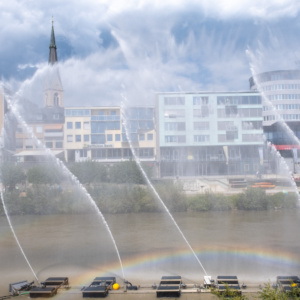
Updated in June 2024 to include an image containing the new metadata property
Many image rights owners noticed that their assets were being used as training data for generative AI image creators, and asked the IPTC for a way to express that such use is prohibited. The new version 2023.1 of the IPTC Photo Metadata Standard now provides means to do this: a field named “Data Mining” and a standardised list of values, adopted from the PLUS Coalition. These values can show that data mining is prohibited or allowed either in general, for AI or Machine Learning purposes or for generative AI/ML purposes. The standard was approved by IPTC members on 4th October 2023 and the specifications are now publicly available.
Because these data fields, like all IPTC Photo Metadata, are embedded in the file itself, the information will be retained even after an image is moved from one place to another, for example by syndicating an image or moving an image through a Digital Asset Management system or Content Management System used to publish a website. (Of course, this requires that the embedded metadata is not stripped out by such tools.)
Created in a close collaboration with PLUS Coalition, the publication of the new properties comes after the conclusion of a public draft review period earlier this year. The properties are defined as part of the PLUS schema and incorporated into the IPTC Photo Metadata Standard in the same way that other properties such as Copyright Owner have been specified.
The new properties are now finalised and published. Specifically, the new properties are as follows:
- Data Mining: a field with a value from a controlled value vocabulary. Values come from the PLUS Data Mining vocabulary, reproduced here:
- http://ns.useplus.org/ldf/vocab/DMI-UNSPECIFIED (Unspecified – no prohibition defined)
- http://ns.useplus.org/ldf/vocab/DMI-ALLOWED (Allowed)
- http://ns.useplus.org/ldf/vocab/DMI-PROHIBITED-AIMLTRAINING (Prohibited for AI/ML training)
- http://ns.useplus.org/ldf/vocab/DMI-PROHIBITED-GENAIMLTRAINING (Prohibited for Generative AI/ML training)
- http://ns.useplus.org/ldf/vocab/DMI-PROHIBITED-EXCEPTSEARCHENGINEINDEXING (Prohibited except for search engine indexing)
- http://ns.useplus.org/ldf/vocab/DMI-PROHIBITED (Prohibited)
- http://ns.useplus.org/ldf/vocab/DMI-PROHIBITED-SEECONSTRAINT (Prohibited, see Other Constraints property)
- http://ns.useplus.org/ldf/vocab/DMI-PROHIBITED-SEEEMBEDDEDRIGHTSEXPR (Prohibited, see Embedded Encoded Rights Expression property)
- http://ns.useplus.org/ldf/vocab/DMI-PROHIBITED-SEELINKEDRIGHTSEXPR (Prohibited, see Linked Encoded Rights Expression property)
- Other Constraints: Also defined in the PLUS specification, this text property is to be used when the Data Mining property has the value “http://ns.useplus.org/ldf/vocab/DMI-PROHIBITED-SEECONSTRAINT“. It can specify, in a human-readable form, what other constraints may need to be followed to allow Data Mining, such as “Generative AI training is only allowed for academic purposes” etc.
The IPTC and PLUS Consortium wish to draw users attention to the following notice included in the specification:
Regional laws applying to an asset may prohibit, constrain, or allow data mining for certain purposes (such as search indexing or research), and may overrule the value selected for this property. Similarly, the absence of a prohibition does not indicate that the asset owner grants permission for data mining or any other use of an asset.
The prohibition “Prohibited except for search engine indexing” only permits data mining by search engines available to the public to identify the URL for an asset and its associated data (for the purpose of assisting the public in navigating to the URL for the asset), and prohibits all other uses, such as AI/ML training.
The IPTC encourages all photo metadata software vendors to incorporate the new properties into their tools as soon as possible, to support the needs of the photo industry.
ExifTool, the command-line tool for accessing and manipulating metadata in image files, already supports the new properties. Support was added in the ExifTool version 12.67 release, which is available for download on exiftool.org.
The new version of the specification can be accessed at https://www.iptc.org/std/photometadata/specification/IPTC-PhotoMetadata or from the navigation menu on iptc.org. The IPTC Get Photo Metadata tool and IPTC Photo Metadata Reference images been updated to use the new properties.
The IPTC and PLUS Coalition wish to thank many IPTC and PLUS member organisations and others who took part in the consultation process around these changes. For further information, please contact IPTC using the Contact Us form.

Last week the IPTC held another very successful member meeting. The 2023 IPTC Autumn Meeting, held virtually this time, had well over 50 attendees from over 30 organisations in at least 15 different countries.
Highlights included Standards Committee approval of a brand new standard, IPTC Sport Schema v1.0, plus the approval of three new versions of existing standards: NewsML-G2 v2.33, IPTC Photo Metadata Standard 2023.1, and Video Metadata Hub v1.5. We will be publishing more information about each of these updates over the coming weeks.
We also heard from two real-world projects in the broadcast industry. One has just completed and the other is still in its planning stages, but both are based on IPTC standards. The ASBU Cloud system was presented by IPTC member Broadcast Solutions, and the DPP Live Production Exchange was presented by new IPTC member Arqiva.
We also heard guest presentation from Will Kreth of the HAND talent identity platform, the latest on C2PA and Project Origin, had a demo of IPTC Sport Schema using MarkLogic from Progress Software (also an IPTC member).
All Working Groups presented their recent work, which included interesting discussions about proposed new NewsCodes vocabularies and how to address the needs of Artificial Intelligence across all of our standards, work that has been going on for years but now acquires a new urgency.
At the IPTC Annual General Meeting 2023, we voted in the existing Board of Directors for another term and and heard updates about all the great work that has taken place at IPTC this year.
It was a great event and we are already looking forward to the next member meeting, to be held in person in New York in April 2024!

The IPTC News Codes Working Group has just released a new batch of changes to the IPTC NewsCodes family of controlled vocabularies.
Note that we skipped the Q2 update this year because there weren’t many changes, and also because there were already so many changes in Q1 of this year.
Media Topic changes
Here’s a summary of changes to Media Topic vocabulary:
- 2 new concepts: sustainability, profit sharing
- 3 retired concepts: justice, restructuring and recapitalisation, soft commodity
- 7 modified names (labels): restructuring and recapitalisation, soft commodity, study of law, sport shooting, sport organisation, recreational hiking and climbing, mountaineering, disabilities (German and Norwegian translations)
- 2 modified definitions: mountaineering, sport organisation
Change to Media Topic tree browser
We have made a small change to the Media Topic tree browser tool: we now display a small “i” icon next to the label name for terms that have notes defined.
The terms that have notes are usually retired terms, and the note gives the user information regarding which terms should be used instead of the retired term. But in other cases notes are used to help explain changes or clarify usage.
Changes to other vocabularies
Other vocabularies have also been updated:
- Content Production Party Role sees two new terms, contentEditor and metadataEditor, that can be used to show changes made by humans or systems (such as AI engines)
- Format had a small change to indicate that it is not just for NewsML 1 documents.
- User Action Type had a small bug fix, changed references to Twitter / X and retired Google Plus as a term. More changes will be coming soon covering other social media platforms and ways to track user interactions with media content.
- The rendition CV has been updated to make it more generic – renditions can apply to any type of media, not just images and video.
- The digitalsourcetype CV had already been updated in July to handle inpainting and outpainting but we mention it again here as a reminder.
Thanks to the representatives from IPTC members AFP, NTB, Bonnier News, ABC Australia, Bloomberg, New York Times and Associated Press for their contributions to the changes this quarter via the NewsCodes Working Group.
We are still working on our regular review of Media Topics – currently we are in the middle of a review of the Economy branch. The review is not yet complete but we hope for it to be ready for the Q4 or Q1 update.
The IPTC is pleased to announce the final agenda for next week’s IPTC Autumn Meeting.
Held online via Zoom from 13.00 to 18.00 UTC from Monday to Wednesday, the meeting will include:
Monday 2 October
- Working Group presentations:
- Video Metadata Working Group who will be proposing a new version of Video Metadata Hub handling metadata specifying whether content can be included in AI training data and other forms of data mining
- Sports Content Working Group who will be proposing the 1.0 version of the new IPTC Sport Schema standard
- Member presentations:
- Demo of how to implement IPTC Sport Schema in MarkLogic and Semaphore from Progress Software
- Guest presentations:
- Update from the HAND project: a new approach to identity in media and entertainment
Tuesday 3 October
- Working Group presentations:
- NewsML-G2 Working Group who will be proposing a new version of NewsML-G2 that includes Digital Source Type metadata to bring it in line with other IPTC standards
- Photo Metadata Working Group who will be proposing a new version of the IPTC Photo Metadata Standard handling metadata specifying whether content can be included in AI training data and other forms of data mining
- NewsCodes Working Group (including a discussion of a proposed new vocabulary on “editorial tone”)
- Member presentations:
- Broadcast Solutions presenting the ASBU Cloud project, based on NewsML-G2
- New member Newsbridge presenting how their systems implement IPTC standards
- Guest presentations:
- Update on Project Origin and C2PA, featuring the CEO of Media City Bergen, Helge Svela
Wednesday 4 October
- IPTC Annual General Meeting 2023
- Election of IPTC Board of Directors and Chair
- Approval of budget for 2023
- Updates from the Managing Director and Chair of the Board of Directors
- IPTC Autumn 2023 Standards Committee meeting
- Votes on new versions of NewsML-G2, Photo Metadata Standard, Video Metadata Hub and presenting proposed new standard IPTC Sport Schema
- Working Group presentations:
- News in JSON Working Group
- Working Group and member presentations:
- Discussion on a simple rights format
- DPP Live Production Exchange (LPX) project from CNN and new member Arqiva
IPTC member representatives can view the full schedule on the IPTC Autumn Meeting 2023 event page in the Members-Only Zone.
Categories
Archives
- December 2025
- November 2025
- October 2025
- September 2025
- August 2025
- July 2025
- June 2025
- May 2025
- April 2025
- March 2025
- February 2025
- January 2025
- December 2024
- November 2024
- October 2024
- September 2024
- August 2024
- July 2024
- June 2024
- May 2024
- April 2024
- March 2024
- February 2024
- December 2023
- November 2023
- October 2023
- September 2023
- August 2023
- July 2023
- June 2023
- May 2023
- March 2023
- February 2023
- January 2023
- December 2022
- November 2022
- October 2022
- September 2022
- August 2022
- July 2022
- June 2022
- May 2022
- April 2022
- March 2022
- February 2022
- January 2022
- December 2021
- November 2021
- October 2021
- September 2021
- August 2021
- July 2021
- June 2021
- May 2021
- April 2021
- February 2021
- December 2020
- November 2020
- October 2020
- September 2020
- August 2020
- July 2020
- June 2020
- May 2020
- April 2020
- March 2020
- February 2020
- December 2019
- November 2019
- October 2019
- September 2019
- July 2019
- June 2019
- May 2019
- April 2019
- February 2019
- November 2018
- October 2018
- September 2018
- August 2018
- July 2018
- June 2018
- May 2018
- April 2018
- March 2018
- January 2018
- November 2017
- October 2017
- September 2017
- August 2017
- June 2017
- May 2017
- April 2017
- December 2016
- November 2016
- October 2016
- September 2016
- August 2016
- July 2016
- June 2016
- May 2016
- April 2016
- February 2016
- January 2016
- December 2015
- November 2015
- October 2015
- September 2015
- June 2015
- April 2015
- March 2015
- February 2015
- November 2014